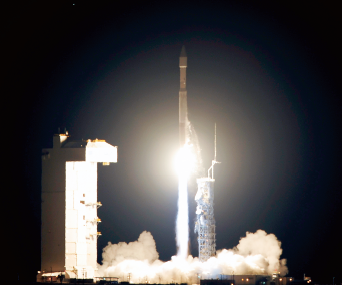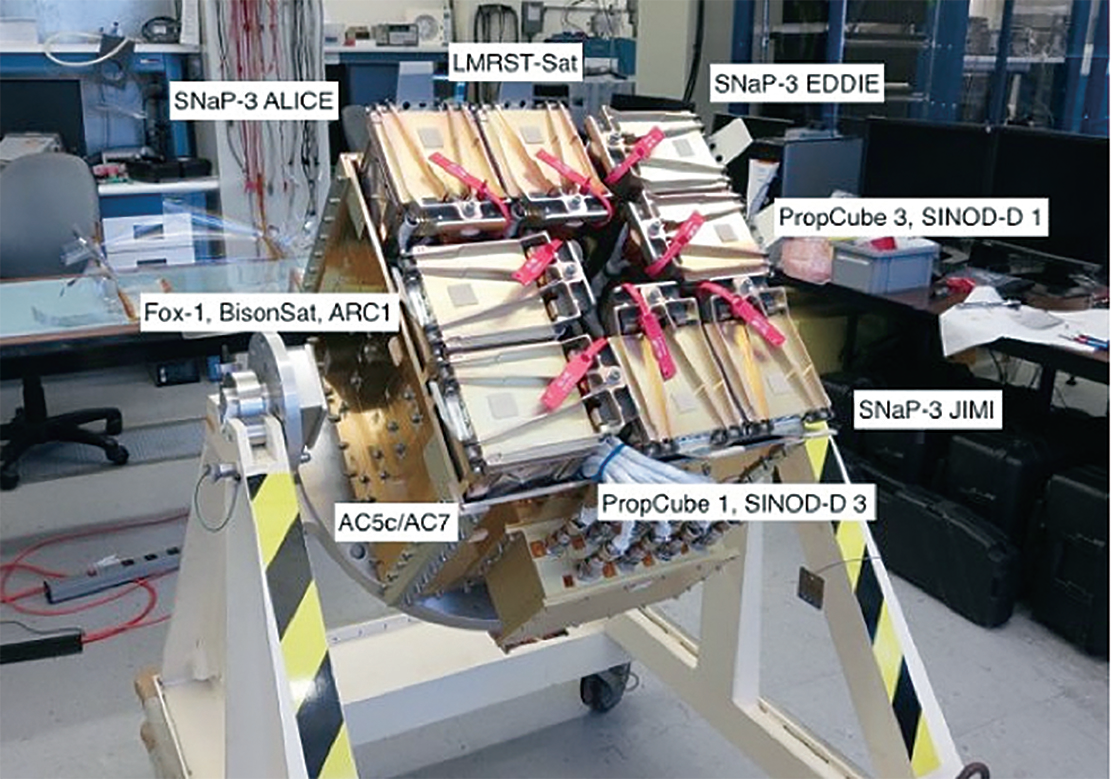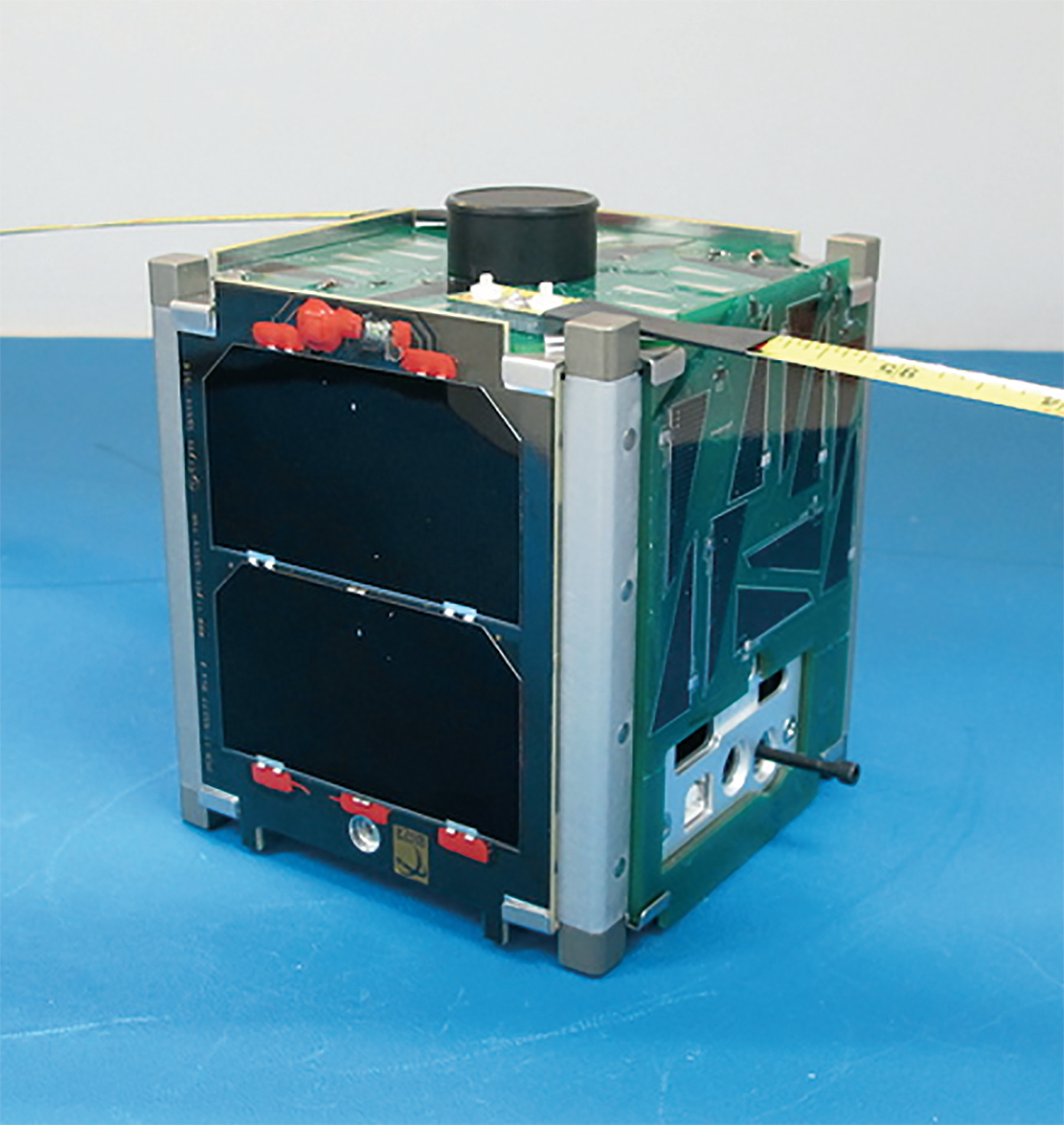A United Launch Alliance (ULA) Atlas V rocket carrying a classified payload for the National Reconnaissance Office (NRO) and 13 CubeSats lifted off from Space Launch Complex-3 October 8 at 5:49 a.m. PDT.

A United Launch Alliance Atlas V rocket carrying a National Reconnaissance Office payload launches from Vandenberg AFB on October 8, 2015. The rocket launched at 5:49 a.m. PDT from Space Launch Complex-3 by Team Vandenberg. U.S. Air Force courtesy photo is by Senior Airman Kyla Gifford.
Designated NROL-55, the mission is in support of national defense. This is ULA’s 10th launch in 2015 and the 101st successful launch since the company was formed in December 2006.
The Atlas V rocket also delivered 13 Government Rideshare Advanced Concepts Experiment (GRACE) CubeSats to orbit. The nine NRO-sponsored CubeSats and four NASA-sponsored CubeSats were mounted to the
Aft-Bulkhead Carrier, which is located on the back end of the Centaur upper stage.
The 13 CubeSats were developed by..
• Aerospace Corporation
• U.S. Army’s Space and Missile Defense Center
• Tyvak
• SRI International
• University of Alaska-Fairbanks
• Salish Kootenai College
• AMSAT
• Jet Propulsion Laboratory.
Weighing 1-5 kilograms, these smallsats were developed, launched and controlled at a fraction of the cost of a typical, operating satellite.
The NRO payload and GRACE CubeSats were launched aboard an Atlas V Evolved Expendable Launch Vehicle (EELV) 401 configuration vehicle, which includes a 4 meter diameter payload fairing.
The Atlas booster for this mission was powered by the RD AMROSS RD-180 engine and the Centaur upper stage, powered by an Aerojet Rocketdyne RL10C-1 engine.
The NRO satellite is believed to be a KH-11 (Kennan) reconnaissance satellite. This platform conducts electro-optical reconnaissance of Earth from a Sun-Synchronous, near polar, LEO.
ULA’s next launch is the Atlas V Global Positioning System (GPS) IIF-11 satellite for the U.S. Air Force, scheduled for October 30 from Space Launch Complex-41 from Cape Canaveral Air Force Station, Florida.
The EELV program was established by the U.S. Air Force to provide assured access to space for Department of Defense and other government payloads. The commercially developed EELV program supports the full range of government mission requirements, while delivering on schedule and providing significant cost savings over the heritage launch systems. The next NRO launch is on schedule for early 2016, also from Vandenberg.

Orbital ATK, Inc. supported this ULA Atlas V successful launch from Vandenberg Air Force Base in California. Using advanced fiber placement manufacturing and automated inspection techniques, Orbital ATK produced the 10-foot diameter composite heat shield on the ULA Atlas V rocket, which provides essential protection for the first stage of the launch vehicle from engine exhaust temperatures in excess of 4,000 degrees Fahrenheit. The large composite structure was fabricated at Orbital ATK’s Iuka, Mississippi, facility. This is the 58th Atlas V launch using Orbital ATK-built composite structures.
This flight marked the 23nd successful flight of the Orbital ATK retro motors. Eight of these solid motors provided thrust for separation of the spent first stage. The ULA Atlas V retrorocket is built at Orbital ATK’s Elkton, Maryland, facility.
“Congratulations on today’s successful launch of NROL-55! ULA is honored to have collaborated with the NRO Office of Space Launch and the Air Force on the integration and launch of the NROL-55 spacecraft to orbit with our Atlas V vehicle,” said Jim Sponnick, ULA vice president, Atlas and Delta Programs. “Launches like this only happen with exceptional teamwork by an extremely talented team and a one-launch-at-a-time focus on mission success. The GRACE CubeSats will perform missions demonstrating tracking technologies, software-defined radio communications and will also conduct other measurements and experiments. We are happy that ULA could play a part in bringing these nano-satellites to orbit along with the NRO payload through a cost-effective rideshare.”
Colonel Clint Hunt, USAF, Director, NRO Office of Space Launch, said, “I commend everyone who made this launch successful. This launch adds another powerful mechanism to the nation’s security toolkit. It also demonstrates the efficiencies of CubeSat rideshare on an NRO mission. This mission is a great example of how NRO, NASA, the Air Force, and our academic colleagues collaborate to amplify innovative technology to support the nation.”

“Orbital ATK-produced structures and components on the ULA Atlas V launch vehicle contributed to another successful launch today,” said Scott Lehr, President of Orbital ATK’s Flight Systems Group. “Our products play a vital role in delivering on mission commitments critical to national security.”
Kimberly Locke of Aerospace Corporation detailed the specifics of the company’s payload aboard the NROL-55 mission.
Riding on the coattails of its older siblings, AeroCubes 1 through 6, the first in the AeroCube-7 (AC-7) trilogy is aboard the Atlas V launch vehicle, which successfully launched from Vandenberg Air Force Base, California, on October 8—the remaining two CubeSats in this series are scheduled for launch in the spring of 2016.
The AeroCube-7 trilogy, supported by the Space Technology Mission Directorate (STMD) at NASA headquarters in Washington, D.C., is designed to demonstrate two different capabilities—high-speed optical transmission of data, and small spacecraft proximity operations. NASA calls the overall mission the Optical Communications and Sensor Demonstration (OCSD) mission.
The first AC-7 flight is a pathfinder that will demonstrate most of the subsystems required for both OCSD missions and will be used to evaluate the performance of the attitude-control system. The pathfinder is also expected to demonstrate optical downlinking at speeds up to 100 megabits per second to a ground-based, 30-cm telescope, using an advanced attitude-control system and a moderate-power, tightly-focused laser beam.
“Much of the pathfinder’s mission is to see how fast we can communicate to Earth from a CubeSat in low-Earth orbit,” said Dr. Richard Welle, Microsatellite Systems Department, Space Materials Laboratory, Technology and Laboratory Operations (TLO), Engineering and Technology Group (ETG).
The second phase of the mission will address the need for low-cost sensors that small spacecraft can use to help them maneuver and operate safely while in close proximity to other spacecraft or objects in space. This will enable multiple small spacecraft to operate cooperatively during science or exploration missions, to approach another spacecraft or object for in-space observation or servicing, or to connect small spacecraft together to form larger systems or networks in space.
According to NASA, the Block II AC-7 satellites will be modified and upgraded as necessary to incorporate any lessons learned from the pathfinder mission and the laser communication system will be tuned to higher data rates provided they can be supported by the attitude-control system. Additionally, the Block-II satellites, flying together, will perform the proximity operations demonstration.

The mission is funded through NASA’s Small Spacecraft Technology Program (SSTP) within STMD. SSTP was created, according to NASA, specifically to develop and demonstrate new technologies and capabilities for small spacecraft.
These smallsats, commonly referred to as CubeSats, are power challenged due to their small size. They can collect and store a relatively small amount of energy, an essential ingredient for performing many operations in space. This power challenge makes it difficult to meet the large power requirements that are typical of high-bandwidth data transmission systems.
Laser communication offers the potential for high-bandwidth communications at power levels well below comparable radio-frequency systems.
“These AeroCubes represent a continuing commitment to determining what can and cannot be done in such a small package,” said Welle.
A CubeSat is a 10-centimeter (about 4 inches) on a side, cube-shaped satellite that conforms to the CubeSat Standard developed by the California Polytechnic State University (CalPoly) at San Luis Obispo. These small satellites are most often ejected into space from a Poly-Picosatellite Orbital Deployer (P-POD). The P-POD is the most widely used interface between CubeSats and launch vehicles, and its design is responsible for the iconic cubic shape.
The common thread or tether, pardon the space pun, is that of technology testing and development. “These small satellites give us and others in the satellite business the opportunity to test power, attitude control, and communications features,” said Welle.
The small size and comparative simplicity of CubeSats encourages rapid development and testing, with a development cycle measured in months instead of the years typical of larger satellites. The entire satellite mechanical design can be incorporated in a single SOLIDWORKS model, which simplifies the design process while making it easier for the design team to identify any potential issues.
Geoffrey Maul, CAD design specialist in the Microsatellite Systems Department, has been the principal designer of several AeroCubes, and brought this experience to the AC-7 design.

“Flexibility is probably the biggest challenge when designing a CubeSat,” said Maul. “When we start a CubeSat design, we have to pick a starting point and, sometimes, that means making certain assumptions that prove to be wrong. My job is to make sure the physical design can adapt to whatever changes are required when those assumptions change.”
The challenge of flexibility is also a feature that allows CubeSat technology to evolve as fast as it has, ultimately leading to the very-high capacity communication system that will fly on AC-7, Welle added.
One of the passengers was the Fox1A CubeSat from The Radio Amateur Satellite Corporation (AMSAT). Barry Baines offers the following information regarding this CubeSat in the organization’s APOGEE VIEW publication.
Fox-1A is part of the ELaNa-XII group of satellites. There is a significant sense of pride in completing a spacecraft that will be used by amateurs, students, and scientists who will benefit from amateur radio capabilities on board the CubeSat, educational opportunities that our spacecraft can provide to the classroom, and the scientific data that will be available from payloads on board provided by university students and faculty.
The Fox-1 mission is an education mission that will host a two-way FM communications transponder and an experiment payload allowing students to relay messages from Earth to space and back to other students somewhere on the planet requiring only a simple walkie-talkie style radio, combined with a small, hand-held antenna.
Fox-1 satellites include two telemetry formats:
• Slow Speed, also called Data Under Voice (DUV) is 200 bps FSK data sent at the same time as the transponder audio. Whenever the transmitter is on, data is being sent. This happens during beacons and during live QSOs.
• High Speed is 9600 bps FSK sent instead of the transponder. This is used for data intensive experiments such as the Virginia Tech Camera and the University of Iowa HERCI experiment. This is only active when commanded from the ground. Users can recognize High Speed because it sounds like an old school computer modem.
FoxTelem, an application from AMSAT, will receive and store both formats, assuming you can feed it audio that does not have the frequencies below 200 Hz filtered. For High Speed, the audio must also extend to include the full 9600bps bandwidth of the FM signal. For both modes this is best achieved from a Software Defined Radio or from the 9600 bps packet port of some radios.
The Fox Telemetry Decoder is being released to demodulate, store and analyze telemetry data from AMSAT’s Fox series of CubeSats. The organization hopes users will also upload received telemetry data to the AMSAT server so thatinformation can be used by other Amateur Scientists and AMSAT research partners, whose experiments fly with the Fox satellites

AMSAT also provided these Fox-1 Operating Hints...
• Use a small beam like the Arrow Antennas Yagi or Elk log periodic, clear of obstructions.
• Select the 67. 0 Hz PL/CTCSS for transmit AMSAT recommends to use no more than 5 watts with a modest gain antenna
• Open your Squelch all the way
• Use a combo headphone/boom mike to reduce feedback/echo (and give you a free hand)
• Use a printout or your laptop, smartphone or tablet to track the satellite path over your QTH
• Apps include Satellite Explorer Pro (iOS) and
• AmsatDroidFREE (Android)
• Have an audio recorder to log the QSO (it is difficult to talk, point the antenna, do PTT operation, remember the callsign, and think - all at the same time)
• Set your transmit and receive frequencies in memories to make tuning easier Twist the antenna as the pass progresses to improve signal strength
For Aerospace’s latest information on the OCSD mission, please visit http://ocsd.aerospace.org.
The AMSAT infosite is located at: http://www.amsat.org/

Sue Mitchell, writing for the University of Alaska—Fairbanks, offers information regarding the university’s CubeSat inclusion in the
NROL-55 mission.
A small research satellite designed and built by University of Alaska Fairbanks students was among 13 launched on October 8 from Vandenberg Air Force Base in California.
The tiny satellite, known as a CubeSat, flew on the NASA National Reconnaissance Office’s Government Rideshare Advanced Concepts Experiment, or GRACE.
The Alaska Research CubeSat, called ARC-1, was the culmination of a UAF Alaska Space Grant Program project five years in the making and the result of work by a whole team of students, as well as collaborations between the College of Engineering and Mines and the Geophysical Institute.

Engineering majors Jesse Frey, left, Morgan Johnson, center, and Patrick Wade hold the “cubesat” they designed and built as part of their work with the Alaska Space Grant program. The CubeSat launched into space on October 8, 2015, from Vandenberg Air Force Base in California. Photo is courtesy of the University of Fairbanks—Todd Paris.
UAF engineering students Patrick Wade and Matt Pacheco hand-delivered the tiny satellite, just under 4 inches square, to California Polytechnic State University in San Luis Obispo for incorporation into the rocket payload last March.
Work on the project started in 2009 under the tutelage of Denise Thorsen, director of ASGP and faculty advisor to the Space Systems Engineering Program at UAF. NASA developed the CubeSat Launch Initiative as a way to give universities access to space. Because they are so small, multiple cubesats can be packed in a rocket used to deploy a larger satellite.
Similar to NRO’s previous cubesat rideshares, GRACE will reach orbit via an ATLAS V rocket, mounted to the aft-bulkhead carrier, located on the aft end of the Centaur upper stage. GRACE will carry a total of 13 cubesats, nine sponsored by the NRO and the four sponsored by NASA’s CubeSat Launch Initiative. The CubeSats are ejected into space once the primary payload is safely on its way.
The team had turned down previous possible launch dates because the orbit wouldn’t get the satellite to a high enough latitude in order to communicate with it from Fairbanks, Thorsen said. “There’s no sense in having a satellite we can’t talk to.”
This launch will put ARC-1 in an elliptical orbit at a latitude just north of Fairbanks and between about 310 and 500 miles from Earth.
ARC-1 will perform three tasks during its roughly one-year lifespan. An

The entire package of CubeSats in position in their P-POD at the California Polytechnic Institute in March 2015, assembled in the payload.
experiment activated at liftoff will collect data about temperature and vibration inside the rocket. The students will also evaluate a novel, low-power attitude control system they developed, and a camera will transmit back images of snow and ice cover. The students will track ARC-1 at the NOAA and NASA Fairbanks Command and Data Acquisition Station at Fox, which hosts a ground station for the students.
Once ejected from the rocket, ARC-1 will begin transmitting a beacon on a ham radio frequency. Any ham radio users around the world who pick up the signal will be asked to send an email message to Thorsen stating when and where they picked up the signal. Thorsen will send each respondent what’s called a QSL card—a written acknowledgement and thanks for the information. Once the ARC-1 orbit is accurately characterized and the cubesat is being tracked, the UAF students will instruct the satellite to transmit information on a specific radio frequency.
“The main goal of our CubeSat was to monitor the rocket launch environment on the ride up,” Thorsen said. “Our CubeSat will collect that data and store it. Once we have proved out the health of the CubeSat and it tells us how much data it collected, then we will give it the command to start downloading that data.”
Information about how well the novel satellite attitude control project is going will be part of the beacon, Thorsen said.

“When ARC-1 is kicked out of the rocket, it’s tumbling, we can tell that by the beacon data,” Thorsen said. “Over time we hope the tumbling will stop and the satellite will be pointed in a particular direction.” All the control and attitude adjustments are preprogrammed into the cubesat.
Thorsen said 36 UAF students have worked on this satellite since the project’s inception. Five were graduate students, another five started as undergraduates who became graduate students. Thirty-two of the students who’ve worked on the project were undergraduate students. Two of the 36 were high school students; one of these is now a freshman at UAF.
Five students attended the launch at Vandenberg Air Force Base: Jesse Frey, Morgan Johnson, Chic O’Dell, Patrick Wade and Matt Pacheco. Thorsen and a graduate student will monitor the launch from Alaska.
The team used facilities within the College of Engineering and Mines and at the Geophysical Institute to make sure the Alaska Research CubeSat met NASA specifications.
What is the Alaska Space Grant Program (ASGP). The program is a consortium of public and private universities and non-profit organizations that sponsors a broad range of programs to enhance teaching, research, and educational outreach within aerospace and earth science, and other NASA related STEM disciplines throughout Alaska.

The Alaska Space Grant Program provides the conduit for education, and the development of a knowledgeable workforce and research infrastructure in support of NASA’s mission.
Specifically, the ASGP mission is:
• To promote Earth and Space Science and technology and other NASA relevant teaching, research, and public service throughout Alaska, with special emphasis on culturally responsive programs to engage native, minority, and non-traditional communities
• We are committed to engaging and creating ACCESS for all students and faculty in the state of Alaska to Alaska Space Grant Program’s NASA related research and education opportunities (Goal 1). We will accomplish this through (i) the development and strengthening our relationships with Alaska’s community colleges and rural campuses; and (ii) the development of distance education and summer opportunities targeted at increasing enrollment in STEM disciplines

BisonSat photo is courtesy of Salish Kootenai College
• We are committed to supporting research and educational opportunities that are RELEVANT to NASA’s mission and the states needs (Goal 2). We will accomplish this by providing (i) opportunities for authentic, hands-on student experiences in science and engineering; and (ii) research infrastructure development opportunities that enhance the collaboration between Alaska faculty and NASA scientist and engineers
• We are committed to enhancing PERMANENT connections between NASA’s mission, and Alaska students, faculty, and citizens (Goal 3). We will accomplish this through supporting (i) opportunities that prepare our students for permanent employment at NASA or other aerospace industries; (ii) NASA related sustainable research infrastructure opportunities; and (iii) opportunities that enable the permanent incorporation of NASA educational materials in the states STEM curriculum
The director of the Alaska Space Grant Program program is Denise Thorsen, who may be contacted at dlthorsen@alaska.edu.
In the summer of 2010, a group of students and faculty at Salish Kootenai College began the work of designing a CubeSat.g.
Salish Kootenai College’s CubeSat is named Nwist ´Qwi´qway in the Salish language and is commonly referred to as BisonSat.
The primary objective of this satellite is educational, with a secondary objective of demonstrating the acquisition of targeted 100-meter or better resolution visible light imagery of the Earth from a CubeSat platform.

Nwist ´Qwi´qway was successfully launched by United Launch Alliance as a passenger payload in the NROL-55 mission.
The data collected by BisonSat will include several high resolution color images of the Flathead Indian Reservation which will be used to help get tribal college students and tribal communities in NASA’s mission, BisonSat is the first CubeSat designed, built, tested, and operated by tribal college students.
For a thorough immersion in the smallsat market segment, consider attending the upcoming, two-day and extremely important SmallSat Symposium.
This highly informative symposium will be conducted on Tuesday, February 23, and Wednesday, February 24, 2016.
The event will occur at the Hogan Lovells Conference Center in Menlo Park, California, and is sponsored by Satnews Publishers and Hogan Lovells.
For further details and to register, please visit http://www.smallsatshow.com/



